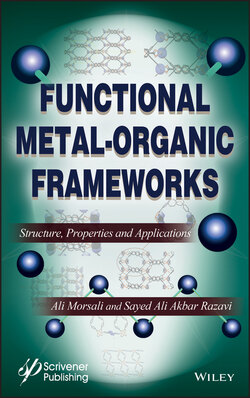Читать книгу Functional Metal-Organic Frameworks - Lida Hashemi, Ali Morsali - Страница 13
1.2 Metal–Organic Frameworks
ОглавлениеAfter pioneering works of Yaghi in 1995 [9], a remarkable number of chemists and material engineers are engrossed in design and application of MOFs. Such great interest among scientists is because of their unique characters which make MOFs suitable for diverse industrial and real-life applications [10, 11].
As mentioned, MOFs are constructed based on organic and inorganic building blocks. In most cases, organic ligands are ditopic or polytopic O-donor ligands based on carboxylates linkers or N-donor ligands based on pyridine pillar spacers. Metal-containing units founded on different kind of metal ions, mostly based on lanthanide cations (like Ln(III), Tb(III), Eu(III), Dy(III) and Sm(III)), transition metals (like 3d cations like Zn(II), Cu(II), Ni(II), Co(II), Fe(III) or Fe(II), Mn(II) and Cr(III) or Cr(II) and heavy transition metals like Cd(II), Zr(IV), Hf(IV)) and main metal ions (Al(III), or some of alkaline or alkaline-earth cations). As a result of such diversity in selection of building blocks, unlimited number of MOFs with different structural and practical properties can be developed by changing metal ion/clusters, using various combinations of these inorganic building blocks and infinite types of organic linkers with different lengths, functionalities and geometries. Additionally, since MOFs are developed based on organic and inorganic building blocks, their hybrid organic–inorganic nature is suitable for tuning the structure and application of MOFs.
MOFs are synthesized by coordination of organic linker to inorganic units by strong bonds [12]. These connections between organic and inorganic building blocks through coordination interactions are such that they create vacant spaces (pores) between the each individual building block. As a result of such porosity, MOFs provide accessible pore volume in the bulk of the materials moreover than accessible area at the surface of material. Right selection of the building blocks makes it possible to vary some parameters, such as the pore size (to increase pore diameter to 98 Å), density (to decrease to 0.126 g·cm−3) and surface area (typically in range from 1,000 to 10,000 m2·g−1) which are exceeding those of traditional porous materials such as zeolites and carbons [13]. In summary, porosity and surface area of MOFs could be tuned through right selection of organic ligands with correct size, flexibility and appropriate inorganic nodes.
The nature, strength and the number of coordination interactions between organic and inorganic building blocks of MOFs are the main reasons for evaluation of their stability. On one hand, selection of building blocks based on Hard-Soft acid-based theory is very beneficial for synthesis of highly stable MOFs [14]. For example hard metal ions such as Al(III) and Zr(IV) [15] could develop stable MOFs through connection with carboxylate-donor organic linker because these building blocks are hard Lewis acid and base, respectively. Another group of stable MOFs are based on selection of soft metal ions like late 3D metal ions and soft N-donor organic ligands like pyrazolate based linkers. On the other hand, the number of coordination bonds between inorganic nodes and organic linkers is another critical factor on the stability of MOFs. The higher number of coordination bonds, the higher stability of the MOF.
Another desirable character of MOFs is their crystalline structure. Selection of well-defined individual molecular building blocks could develop regular structure and periodic frameworks. As a result of their regular crystalline structure, we can tune their chemical and physical properties through logical designing of the framework and right selection of building blocks.
One of the most important advantages of MOFs from other conventional polymers or porous materials is the fact that we can tailor their chemical properties through rational choice of functional groups. Tunability in chemical functionality of MOFs could be provided via three functionalization strategies including selection of functional organic ligand, functionalization of inorganic nodes and functionalization of vacant spaces (pores) inside the framework of MOFs (Figure 1.3) [14, 16]. These functions could be introduced prior to the self-assembly process by selection of desirable functional building blocks (pre-synthesis functionalization strategy) or after synthesis of the frameworks (post-synthesis functionalization strategy) [17, 18]. Unlimited ways for functionalization of MOFs is key factor to control their chemical properties and host–guest interactions. Definitely, we can state that tunability in chemical functionality and consequent ability in control over host–guest chemistry of MOFs has very essential roles in absorbing the attraction of scientist toward MOFs.
Figure 1.3 Three strategies for functionalization of MOFs.
Considering the diverse and useful characteristics of MOFs including regular crystalline structure, high porosity and surface area, hybrid inorganic–organic nature, satisfactory structural stability and tunability in chemical functionality, they are employed for different types of applications such as gas storage and separation [19–23], heterogeneous catalysis [24, 25] and photocatalysis [26–28], sensing [29–33], removal and separation of hazardous chemicals [34–36], drug delivery [37], bio sensing [38–41] and other medical applications [42] electrical conductivity [43] and electrochemical applications [44], ion storage and conductivity [45, 46], and designing MOF-based energetic materials [47]. Such diversity in chemical properties and application of MOFs show that intensive studies are necessary to identify the maximum capability of MOFs for each type of applications.
